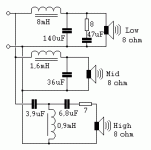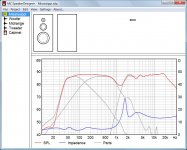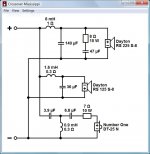Hallo all,
I bought 2 speaker emty speaker cabinets with fiters in. I want to buy new speakers but I do not know the frequency range and the filterlow-mid-high pass frequency.
All formula's I found did not give the component parts they used in this filter.
Can somebody tell me the crossover points of this filter?
Thanks in advance.
Regards.
I bought 2 speaker emty speaker cabinets with fiters in. I want to buy new speakers but I do not know the frequency range and the filterlow-mid-high pass frequency.
All formula's I found did not give the component parts they used in this filter.
Can somebody tell me the crossover points of this filter?
Thanks in advance.
Regards.
Attachments
Hallo QSerraTico_Tico,
I can only give impedance and frequency in this, it calculates then the values of the parts.
My problem is that I know the values but I do not know the frequency.
I can only give impedance and frequency in this, it calculates then the values of the parts.
My problem is that I know the values but I do not know the frequency.
Hallo QSerraTico_Tico,
I can only give impedance and frequency in this, it calculates then the values of the parts.
My problem is that I know the values but I do not know the frequency.
Just try!!
Most probably it's Butterworth.
Try with different frequencies till you get a match with the values of your parts.
I miss the DC blocking caps on the mids.
Last edited:
Dissi,
Thank you very much for this.
This is what I was looking for.
When I change some components, can I ask you again for new data ?
Regards.
M
Thank you very much for this.
This is what I was looking for.
When I change some components, can I ask you again for new data ?
Regards.
M
Hi Mississippi,
Your crossover has two mysteries. As QSerraTico_Tico already mentioned, there is no serial capacitor in the midrange section and the midrange driver runs unfiltered at low frequencies. That only makes sense in a 2.5-way system. So the question is: Are woofer and midrange of the same size and do they share the same volume in the cabinet or is the midrange driver smaller and in a separate little housing?
The second mystery is the gap between 1 and 1.5 kHz. Either the original midrange had a rising frequency response and filled the gap or the original tweeter did. However a crossover frequency of 1.5 kHz is too low for most of the dome tweeters, perhaps it was originally a closed cone tweeter.
Please give us some more information. What are the dimensions of the cabinet and what is the driver size? Is it a vented loudspeaker? A picture and brand and model would help very much.
Your crossover has two mysteries. As QSerraTico_Tico already mentioned, there is no serial capacitor in the midrange section and the midrange driver runs unfiltered at low frequencies. That only makes sense in a 2.5-way system. So the question is: Are woofer and midrange of the same size and do they share the same volume in the cabinet or is the midrange driver smaller and in a separate little housing?
The second mystery is the gap between 1 and 1.5 kHz. Either the original midrange had a rising frequency response and filled the gap or the original tweeter did. However a crossover frequency of 1.5 kHz is too low for most of the dome tweeters, perhaps it was originally a closed cone tweeter.
Please give us some more information. What are the dimensions of the cabinet and what is the driver size? Is it a vented loudspeaker? A picture and brand and model would help very much.
The cabinets are 54 * 65 * 53 cm (h * b * d). Both vented.
The low cabinet has the low filter and the speakerhole is 15".
The mid-high cabinet has also 1 speakerhole of 15".
So the mid-high speaker is 1 thing that has 2 speakers in 1 construction.
I think it looks link LEM K6 low ? mid/high systems.
The low cabinet has the low filter and the speakerhole is 15".
The mid-high cabinet has also 1 speakerhole of 15".
So the mid-high speaker is 1 thing that has 2 speakers in 1 construction.
I think it looks link LEM K6 low ? mid/high systems.
Last edited:
Ok, then it's a PA speaker consiting of two equal cabinets of approximately 120 litres. One cabinet holds a 15" professional woofer and the other one a 15" coaxial driver. If the cutout holes are actually 15", then the drivers have to be even larger!
I'm not really familiar with this kind of speakers and can not recommend something. The drivers are expensive and it will be difficult to find the ones working best in your setup. However, if you propose some drivers, I offer to check the results, provided manufacturer data are sufficient to make a rough simulation.
Pro audio • Europe Audio
I'm not really familiar with this kind of speakers and can not recommend something. The drivers are expensive and it will be difficult to find the ones working best in your setup. However, if you propose some drivers, I offer to check the results, provided manufacturer data are sufficient to make a rough simulation.
Pro audio • Europe Audio
Are the tweeter speakers in place? Are they in series or parallel?
I would do changes to the crossover. If the tweeters are in parallel, you can make them parallel, I would remove the 140 uF, put the 3.9 uF where the 36 uF is, put the 6.8 uF where the 3.9 uF was and put the 36 uF where the 6.8 uF was. This is in case the tweeters are non-piezo that can go down to 1k Hz.
I would do changes to the crossover. If the tweeters are in parallel, you can make them parallel, I would remove the 140 uF, put the 3.9 uF where the 36 uF is, put the 6.8 uF where the 3.9 uF was and put the 36 uF where the 6.8 uF was. This is in case the tweeters are non-piezo that can go down to 1k Hz.
@ Dissi:
I think I want to use the folowing speakers:
Beyma SM115/N; RCF L15P540 and as a tweeter
Celestion CDX1-1430 NEODYMIUM COMPRESSIE-DRIVER 1 INCH 50 W. 8 OHM
BEYMA TD 194 Profesionele hoorn.
@ strawberry:
Can you show me the curves what that brings to me ??
Thanks in advance.
Regards,
M.
I think I want to use the folowing speakers:
Beyma SM115/N; RCF L15P540 and as a tweeter
Celestion CDX1-1430 NEODYMIUM COMPRESSIE-DRIVER 1 INCH 50 W. 8 OHM
BEYMA TD 194 Profesionele hoorn.
@ strawberry:
Can you show me the curves what that brings to me ??
Thanks in advance.
Regards,
M.
With those drivers, remove the 140 uF and put the 36 uF there. Put a 14 uF in place of the 36 uF. Put a 2.2 uF in place of the 3.9 uF, remove the 6.8 uF. Put the tweeters in parallel to the same points of the crossover. Enjoy.
For fun, try the 140 uF in the first position, in front of the inductor to the midrange. This will remove its bass, in case there is too much bass in the speaker.
If the tweeters are too loud, put an 8 ohm resistor in series with the 7 ohm, or replace with a 16 ohm. If too muted tweeters now, replace the lot with a 10 ohm. Another way to mute the tweeters with your extra 8 ohm resistor is to put it in parallel with the two tweeters already in parallel. That is probably smarter.
For fun, try the 140 uF in the first position, in front of the inductor to the midrange. This will remove its bass, in case there is too much bass in the speaker.
If the tweeters are too loud, put an 8 ohm resistor in series with the 7 ohm, or replace with a 16 ohm. If too muted tweeters now, replace the lot with a 10 ohm. Another way to mute the tweeters with your extra 8 ohm resistor is to put it in parallel with the two tweeters already in parallel. That is probably smarter.
Last edited:
When the speakers are delivered (I must still order them) I will do the test you mention.
How do you come to the data you give? Can you also simulate ?
How do you come to the data you give? Can you also simulate ?
Or you can make a combination for the tweeter, replace the 7 ohm for a 10 ohm and put a 10 ohm in parallel with the two tweeters. That is the best solution.
Thanks strawberry, I will order some extra capacitors.
I's a pitty that the "simulation curves" are in your head, I cannot see them here so it's for me a great gess now what realy happens.
I's a pitty that the "simulation curves" are in your head, I cannot see them here so it's for me a great gess now what realy happens.
If you put the discarded capacitors, 3.9 and 6.8, in parallel, you get 11. You don't need to buy the 14 uF for the mid range. 11 will do.
When you order your 2 or 2.2 uF capacitors, order two 16 ohm resistors as well. One in parallel with each pair of parallel tweeters will attenuate well in case they are too loud with the 7 ohm resistor.
When you order your 2 or 2.2 uF capacitors, order two 16 ohm resistors as well. One in parallel with each pair of parallel tweeters will attenuate well in case they are too loud with the 7 ohm resistor.
Last edited:
- Status
- Not open for further replies.
- Home
- Loudspeakers
- Multi-Way
- Help with speakerfilter


